What is Electrical Metallic Tubing (EMT)?
1. Introduction
Electrical conduits are essential components in safeguarding wiring systems within buildings and infrastructure. Selecting the appropriate type of conduit is critical for ensuring the safety, durability, and compliance of an electrical installation. Among the various conduit types available, Electrical Metallic Tubing (EMT) and rigid conduit are two of the most commonly utilized. Both serve the purpose of protecting electrical wiring, but they differ significantly in terms of material, strength, durability, cost, and suitability for different environments.
This article explores the key differences between EMT and rigid conduit, delving into their applications, compliance with industry standards, and corrosion protection requirements. By understanding these factors, electricians, contractors, and engineers can make informed decisions when choosing the appropriate conduit type for their projects.

2. Understanding EMT Conduit
2.1 What Is EMT Conduit?
Electrical Metallic Tubing (EMT) is an unthreaded, thin-walled raceway with a circular cross-section designed for the physical protection and routing of conductors and cables. EMT is typically made of steel (ferrous) with protective coatings or aluminum (nonferrous).
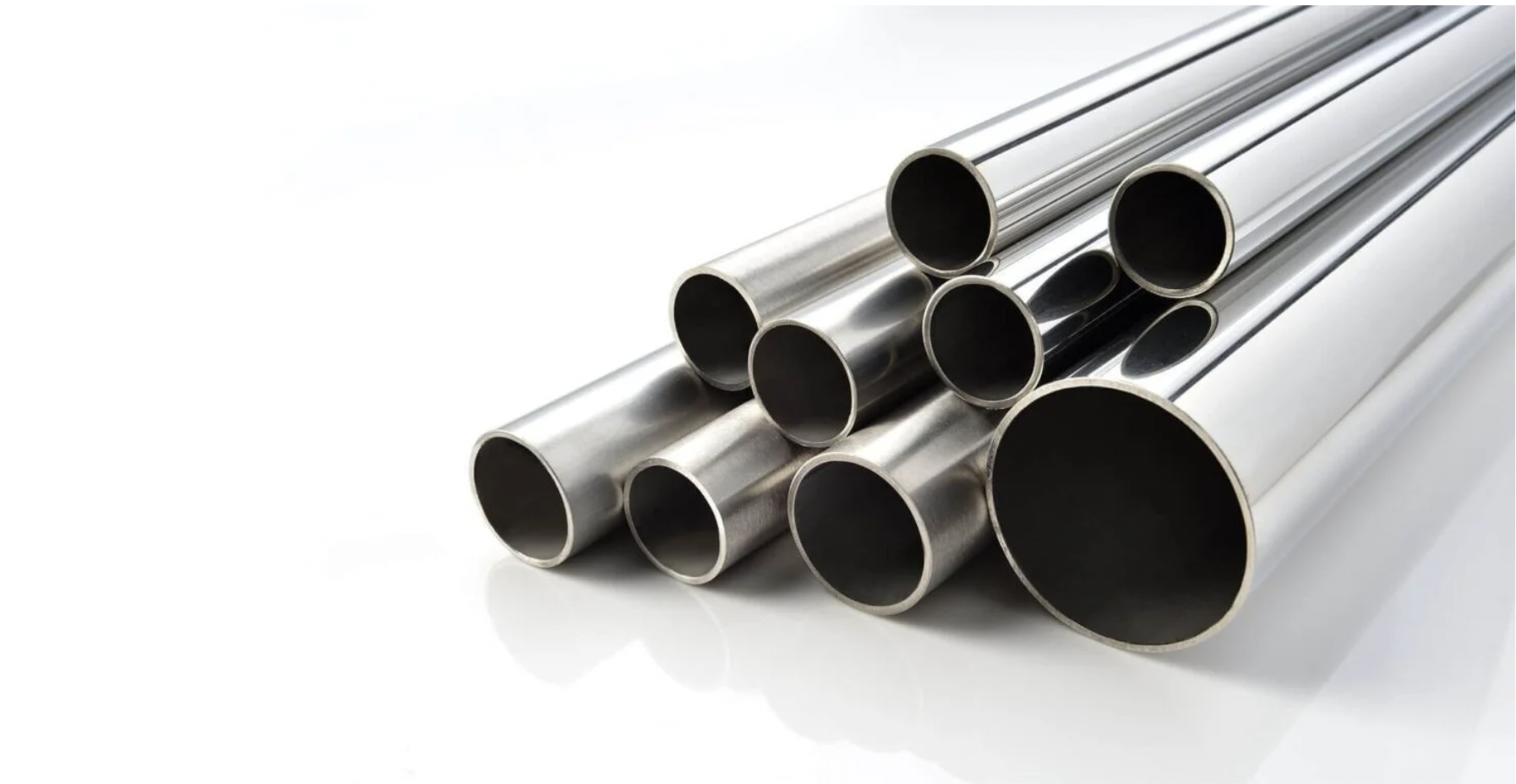
2.2 Characteristics of EMT Conduit
2.2.1 Temperature Range
EMT is generally designed to operate within a temperature range of approximately -10°C to 60°C (14°F to 140°F), with some variants suitable for -30°C to 60°C (-22°F to 140°F). This range can vary based on the raw materials used, so it's important to verify specifications with your supplier. These temperatures cover most standard indoor and moderate outdoor conditions.
However, EMT may not perform optimally in extreme temperatures outside this range. In environments with significantly higher or lower temperatures, special considerations or alternative conduit materials may be necessary.
2.2.2 Compression Resistance
EMT offers good resistance to compressive forces due to its steel construction but is not as robust as Rigid Metal Conduit (RMC) or Intermediate Metal Conduit (IMC). While there isn't a specific standard defining compression resistance for EMT in many codes, it is expected to withstand normal mechanical stresses encountered during installation and use. For applications requiring higher compression resistance, RMC or IMC may be more appropriate.
2.2.3 Burning Conditions
Both aluminum and steel are non-combustible materials when used in the form of extruded Rigid Metal Conduit or EMT. Aluminum will melt when temperatures exceed its melting point, ranging from 600°C to 660°C (1,100°F to 1,220°F), but it does not burn. Since EMT is considered non-combustible by building codes, it does not have specific fire ratings. However, it's important to note that while EMT itself is not flammable, it can be affected by extreme heat. Under high temperatures, EMT can lose structural integrity and may deform or warp. In fire scenarios, EMT can conduct heat, potentially impacting nearby wiring and components.
2.2.4 UV Tolerance
EMT is typically coated with a protective layer to resist corrosion but is not specifically designed for high UV resistance. Prolonged exposure to ultraviolet (UV) rays can deteriorate the coating, affecting the conduit’s protective properties. For installations exposed to direct sunlight or harsh outdoor conditions, using UV-resistant coatings or alternative conduit materials like PVC or specially treated metal conduits may be necessary.
3. Sizes and Color Standards of EMT Conduit
3.1 Sizes of Electrical Metallic Tubing

The outside diameter and the minimum weight of finished EMT should conform to the specifications indicated in relevant tables The standard length of EMT is typically 3.05 meters (10 feet) with a tolerance of ±6.35 mm (±1/4 inch).
3.2 Color Standards of EMT
The use of colored conduit is becoming more common in building design and construction. Many facility managers recognize the benefits of colored conduit and have developed their own guidelines for its application in new projects, including smart buildings, government facilities, and educational institutions.
Currently, the National Electrical Code (NEC) and other NFPA/UL standards do not establish official color codes for raceways or cables in new construction projects. The electrical industry lacks an official color standard for conduit or EMT. There are no prescribed colors for different circuits or voltage levels, so color choices for EMT are often influenced by architectural preferences rather than functional purposes.

Although there are no formal requirements, informal practices have developed over time. Certain industries or companies may adopt their own color-coding standards to meet specific operational needs or safety protocols.
Here are some commonly used colors for EMT and their typical applications:
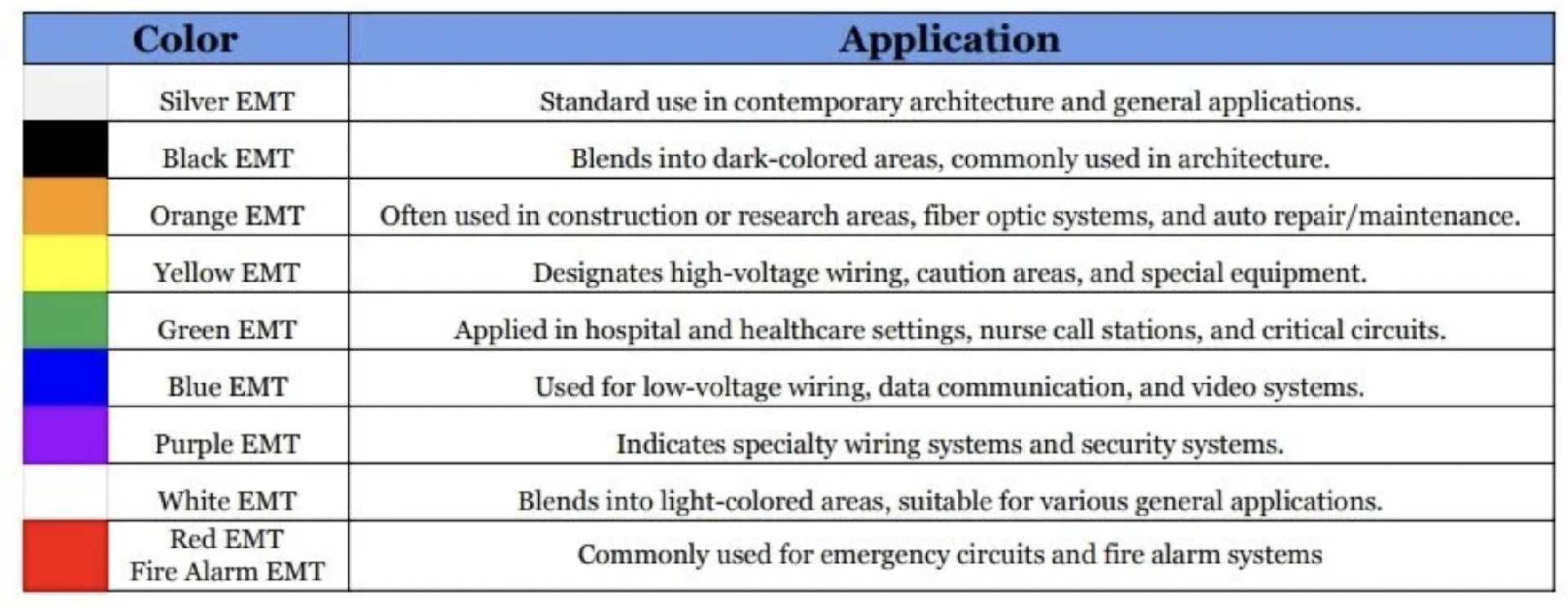
4. When and Where Can EMT Conduit Be Used?
EMT is versatile and can be used in various settings, but its use is subject to specific conditions outlined by the National Electrical Code (NEC):
4.1 Permitted Uses
4.1.1 Exposed and Concealed
EMT is permitted for both exposed and concealed installations, making it suitable for a wide range of applications.
4.1.2 Corrosion Protection
EMT, including elbows, couplings, and fittings, can be installed in concrete, in direct contact with the earth, or in areas with severe corrosive conditions, provided that adequate corrosion protection is applied and the installation is approved as suitable for the environment.
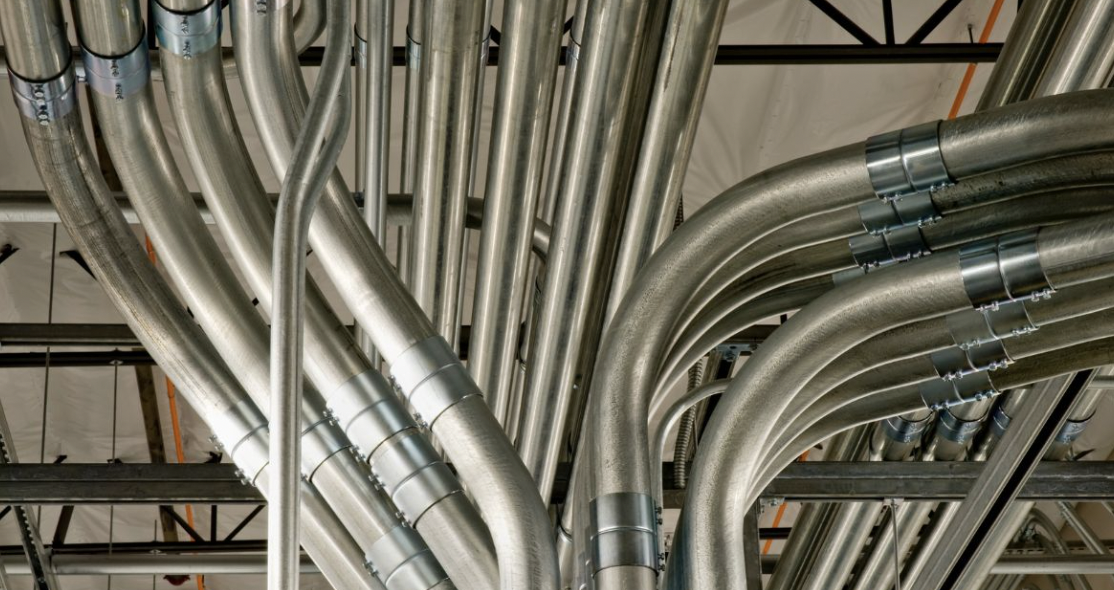
4.1.3 Wet Locations
EMT can be used in wet locations if all supports, bolts, straps, and screws are made of corrosion-resistant materials or are protected by corrosion-resistant coatings.
4.2 Prohibited Uses
4.2.1 Physical and Environmental Limitations
EMT is not suitable for areas with severe physical damage, corrosive environments, or where it could be exposed to moisture, such as in cinder concrete without proper protection.
4.2.2 Installation Restrictions
EMT should not be used in hazardous locations unless permitted by specific NEC articles, nor should it support luminaires or equipment except for conduit bodies.
4.2.3 Corrosion Concerns
To prevent galvanic corrosion, avoid contact between dissimilar metals. Aluminum fittings are acceptable with steel EMT if not in corrosive conditions.
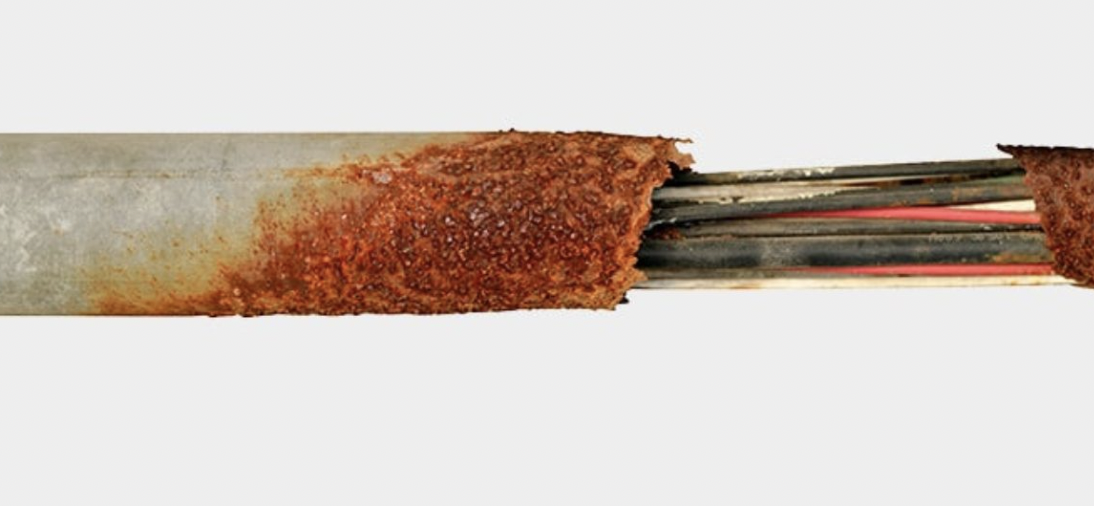
5. Advantages of EMT Conduit
5.1 Cost-Effective
EMT is typically more affordable than other types of metal conduits like Rigid Metal Conduit (RMC) and Intermediate Metal Conduit (IMC). This cost advantage is due to its thinner wall construction, which reduces material costs while still providing sufficient protection for electrical wiring. The reduced expense can be significant in large-scale installations or budget-sensitive projects, contributing to overall savings without compromising safety.
5.2 Ease of Installation
EMT is known for its lightweight nature, simplifying handling and reducing physical strain on installers. Its lighter weight allows for easier transportation and positioning on-site. EMT can be cut with standard pipe-cutting tools and bent with manual or mechanical benders. This ease of manipulation not only speeds up the installation process but also minimizes the need for specialized equipment, further reducing labor time and costs.
5.3 Flexibility
One of EMT's notable advantages is its flexibility. It can be easily bent and shaped to navigate around obstacles or fit specific design requirements. This flexibility is achieved with standard bending tools, making adjustments straightforward during installation. The ability to customize the conduit layout quickly helps adapt to changes or complex routing needs, streamlining the installation process and improving overall system efficiency.
5.4 Aesthetic Appeal
The smooth, clean surface of EMT contributes to its aesthetic appeal, especially in applications where the conduit is visible. Its sleek appearance can blend well with modern architectural designs and maintain a neat look in exposed installations. This can be advantageous in settings where visual impact is a consideration, such as in open ceilings or visible conduit runs.
5.5 Versatility
EMT's versatility is evident in its wide range of applications. It is suitable for residential, commercial, and industrial settings, accommodating various types of electrical systems. Whether used in homes, office buildings, or manufacturing facilities, EMT provides a reliable solution for protecting and routing electrical wiring. Its adaptability to different environments and installation requirements makes it a popular choice across diverse projects.
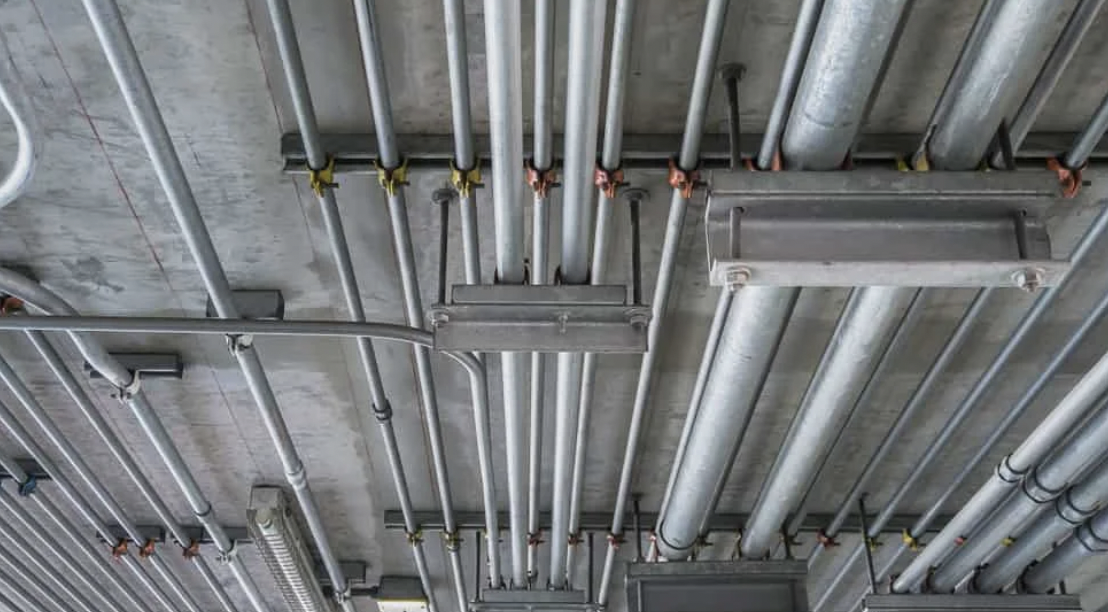
6. Limitations of EMT Conduit
6.1 Limited Corrosion Resistance
While EMT is coated to resist corrosion, it is less durable than Rigid Metal Conduit (RMC) in highly corrosive environments. It is generally not suitable for wet or damp locations unless additional protection or special coatings are applied. For areas exposed to significant moisture or corrosive substances, alternative conduit types with enhanced water resistance, such as PVC or specially coated metal conduits, are preferable.
6.2 Less Robust Protection
Compared to RMC or Intermediate Metal Conduit (IMC), EMT offers less physical protection due to its thinner walls. This makes it more susceptible to damage from impacts or mechanical stress. In applications where substantial physical protection is necessary, such as in areas with heavy equipment or high traffic, EMT might not provide sufficient safeguarding for the wiring it encases.
6.3 Not Suitable for High-Voltage Applications
EMT is generally not recommended for high-voltage applications where additional insulation and protection are crucial. Its design and construction are intended for lower voltage and indoor applications where the risk of electrical faults and exposure is lower. For high-voltage scenarios, conduits with greater insulation and protective features are required.
6.4 Requires Proper Support and Installation
To ensure optimal performance, EMT must be properly supported and secured according to code requirements. Inadequate support or improper installation can lead to problems such as sagging or misalignment of the conduit, which can affect the overall safety and functionality of the electrical system. Proper installation practices are essential to avoid these issues.
6.5 Lack of Insulation
EMT provides only a physical barrier and does not offer insulation for the electrical wiring inside. Additional insulation and grounding measures are often needed to ensure the safe and effective operation of the electrical system, particularly in sensitive or complex installations. The absence of inherent insulation in EMT means that extra steps must be taken to meet safety and performance requirements.

Connect with Confidence
Your professional EMT supplier
